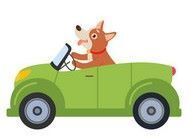With careful planning, caution, and patience, a new dog can be introduced into a home that already has a resident cat or dog, and all can live in the same household contentedly. Be aware that while some pets become instant and life-long buddies, others may have long term objections and overall intolerance to one another.
As a general rule, opposite-sex introductions tend to go smoother than same-sex introductions. Also, if the dogs are neutered or spayed, you will have an easier time introducing them and prevent an unwanted litter. Below are some guidelines to assist in a positive introduction.
Dog, Meet Dog
Introduce the two dogs on neutral territory, somewhere neither dog has occupied for very long, such as at a nearby park. This will keep any territorial fighting instincts from interfering with the introduction.
Your present dog should be well trained before adding another dog. Being able to control your dog’s behavior by using basic commands is essential. Every dog should be trained using a positive reinforcement training method.
Keep the dogs on a leash in case you need to separate/control them.
Young dogs or puppies will most likely be friendly, but if they get too exuberant, an older dog may be initially less tolerant of that behavior. A puppy may not recognize subtle body postures from adult dogs signaling that they've had enough. Be aware that well-socialized adult dogs with good temperaments may set limits with puppies with a warning growl or snarl. These behaviors are normal and should be allowed. However, adult dogs who are not well socialized, or who have a history of fighting with other dogs, may attempt to set limits with more aggressive behaviors. Do not leave the puppy alone with the adult dog until you are sure it is safe. Be sure to give the adult dog some quiet time away from the puppy, and individual attention.
If possible, try to keep the new dog calm and controlled in the presence of the resident dog. This will help them gradually work out social status. Keep the resident dog controlled and calm also, so as to not intimidate the new dog. Use positive reinforcement to encourage friendly interaction.
Once the dogs accept one another, make sure you give each dog individualized attention. Be sensitive to signs of stress or incompatibility. Supervise their interactions. Recognize a balance between too much roughness and the natural behavior of dogs working out a social order. Do not impose your preference for which dog should be dominant. That can confuse the dogs and create further problems.
Provide them each a place to feel secure and safe in your home. Your first dog should
be able to relax in his/her spot without worrying that he/she needs to protect it. At meal time, feed them at the same time but in separate areas of a room. Separate with a gate or in different rooms if either dog seems anxious.
In cases of extreme aggression by either dog, it may not be worthwhile to proceed.
You may want to enlist the advice/assistance of a qualified trainer to ensure you are handling the introduction properly and safely. There are also numerous online resources such as the ASPCA.
Dog, Meet Cat
Before introducing a new dog to a cat, try to determine if the dog will try to harm the cat.
If it is an adult dog, ask the previous owner about any of the dog’s interactions with cats. If it is a shelter dog, ask the staff if they have any knowledge of the dog’s history with cats.
As a general rule, young puppies are unlikely to harm an adult cat and can be introduced under supervision to ensure they don’t get too exuberant and the interaction is positive for both pets.
Confine the cat temporarily to a separate room with his/her litter box, food, water, bedding, and scratching post. This will allow the two pets to smell and hear each other under the door without a direct confrontation.
Swap bedding materials so that each one can get accustomed to one another’s scent. Allow them to check out each other’s living quarters.
Keep the dog on a leash during its first few interactions with the cat so you can maintain control of the situation. A loose cat that runs can trigger the predator instinct in a dog and a leash will help you control that urge to chase.
Keep the introductions low key and don’t force them to be around one another. Let them check out one another at their own pace.
Cats that have had positive experiences with dogs are more likely to accept a new dog.
Make sure the cat’s litter box and food are kept out of reach from the dog and the cat has a place to escape. Both pets need their own defined space to eat and sleep without being infringed upon by the other pet.









